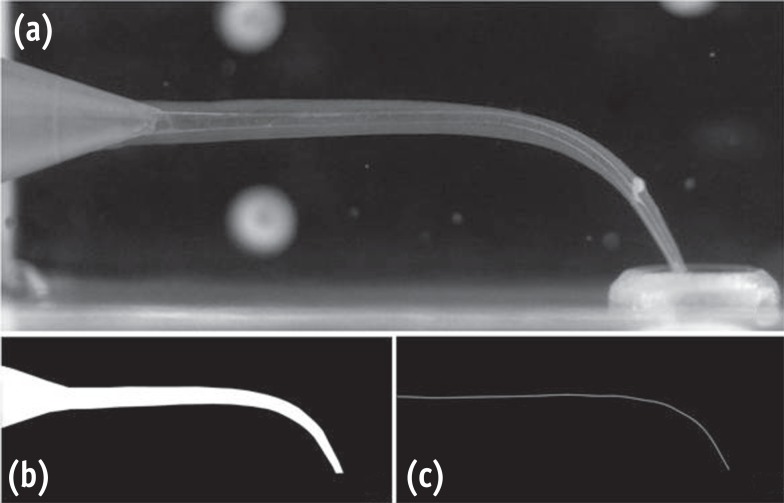Search
- Page Path
- HOME > Search
- Marginal and internal fit of nano-composite CAD/CAM restorations
- So-Hyun Park, Yeon-Jee Yoo, Yoo-Jin Shin, Byeong-Hoon Cho, Seung-Ho Baek
- Restor Dent Endod 2016;41(1):37-43. Published online January 19, 2016
- DOI: https://doi.org/10.5395/rde.2016.41.1.37

-
 Abstract
Abstract
 PDF
PDF PubReader
PubReader ePub
ePub Objectives The purpose of this study was to compare the marginal and internal fit of nano-composite CAD-CAM restorations.
Materials and Methods A full veneer crown and an mesio-occluso-distal (MOD) inlay cavity, which were prepared on extracted human molars, were used as templates of epoxy resin replicas. The prepared teeth were scanned and CAD-CAM restorations were milled using Lava Ultimate (LU) and experimental nano-composite CAD/CAM blocks (EB) under the same milling parameters. To assess the marginal and internal fit, the restorations were cemented to replicas and were embedded in an acrylic mold for sectioning at 0.5 mm intervals. The measured gap data were pooled according to the block types and measuring points for statistical analysis.
Results Both the block type and measuring point significantly affected gap values, and their interaction was significant (
p = 0.000). In crowns and inlays made from the two blocks, gap values were significantly larger in the occlusal area than in the axial area, while gap values in the marginal area were smallest (p < 0.001). Among the blocks, the restorations milled from EB had a significantly larger gap at all measuring points than those milled from LU (p = 0.000).Conclusions The marginal and internal gaps of the two nano-composite CAD/CAM blocks differed according to the measuring points. Among the internal area of the two nano-composite CAD/CAM restorations, occlusal gap data were significantly larger than axial gap data. The EB crowns and inlays had significantly larger gaps than LU restorations.
-
Citations
Citations to this article as recorded by- Dimensional accuracy of additive and subtractive manufactured ceramic-reinforced hybrid composite inlays: a CBCT-based in vitro study
Arwa Daghrery, Thilla Sekar Vinothkumar, Hissah Majrashi, Ghadah Faqihi, Rahaf Gofshi, Shroog Almasoudi, Rehaf Madkhali, Walter Yu Hang Lam, Honey Lunkad, Hemant Chourasia, Akhilanand Chaurasia
Scientific Reports.2025;[Epub] CrossRef - The Influence of Extra-Fine Milling Protocol on the Internal Fit of CAD/CAM Composite and Ceramic Crowns
João Paulo Mendes Tribst, Fatema Hosseini, Rafaela Oliveira Pilecco, Carlos Manuel Serrano, Cornelis Johannes Kleverlaan, Amanda Maria de Oliveira Dal Piva
Materials.2024; 17(22): 5601. CrossRef - Marginal fit of three different nanocomposite inlays fabricated with computer-aided design/computer-aided manufacturing (CAD/CAM) technology: a comparative study
Hyunsuk Choi, Jae-Young Jo, Min-Ho Hong
Journal of Yeungnam Medical Science.2024; 41(2): 80. CrossRef - Clinical comparison of marginal fit of ceramic inlays between digital and conventional impressions
Franklin Guillermo Vargas-Corral, Américo Ernesto Vargas-Corral, Miguel Angel Rodríguez-Valverde, Manuel Bravo, Juan Ignacio Rosales-Leal
The Journal of Advanced Prosthodontics.2024; 16(1): 57. CrossRef - Evaluation of Fitness and Accuracy of Milled and Three-Dimensionally Printed Inlays
Yoen Ah Lim, Jeong Mi Kim, Yoorina Choi, Sujung Park
European Journal of Dentistry.2023; 17(04): 1029. CrossRef - Microscopic Inspection of the Adhesive Interface of Composite Onlays after Cementation on Low Loading: An In Vitro Study
Tiago Magalhães, Rita Fidalgo-Pereira, Orlanda Torres, Óscar Carvalho, Filipe S. Silva, Bruno Henriques, Mutlu Özcan, Júlio C. M. Souza
Journal of Functional Biomaterials.2023; 14(3): 148. CrossRef - Triple scan evaluation of internal and marginal adaptation of overlays using different restorative materials
Cynthia Kassis, Carina Mehanna, Pierre Khoury, Hani Tohme, Carlos Enrique Cuevas‐Suárez, Rim Bourgi, Monika Lukomska‐Szymanska, Louis Hardan
Journal of Esthetic and Restorative Dentistry.2023; 35(3): 493. CrossRef - Effect of Bonding Protocols on the Performance of Luting Agents Applied to CAD–CAM Composites
Bruna Hilgemberg, Fabiana Suelen Figuerêdo de Siqueira, Andres Felipe Millan Cardenas, Josiane Loch Ribeiro, Andrés Dávila-Sánchez, Salvatore Sauro, Alessandro Dourado Loguercio, Cesar Augusto Galvao Arrais
Materials.2022; 15(17): 6004. CrossRef - Marginal and internal fit and fracture resistance of three‐unit provisional restorations fabricated by additive, subtractive, and conventional methods
Mehran Falahchai, Samiye Rahimabadi, Ghazaleh Khabazkar, Yasamin Babaee Hemmati, Hamid Neshandar Asli
Clinical and Experimental Dental Research.2022; 8(6): 1404. CrossRef - Analysis of Cosmetic Effect of Nanocomposite Resin on Anterior Teeth
Yubo Wang, Junfu Li, Daiyun Chen, Li Li, Tao Huang
Computational and Mathematical Methods in Medicine.2021; 2021: 1. CrossRef - Microleakage and Marginal Integrity of Direct and Indirect Composite Resin Restorations in MOD Cavities After Thermo-Mechanical Loading
Ayşe Aslı ŞENOL, Pınar YILMAZ ATALI, Erkut KAHRAMANOĞLU
Clinical and Experimental Health Sciences.2021; 11(3): 564. CrossRef - Marginal adaptation of different hybrid ceramic inlays after thermal cycling
Kun Qian, Xin Yang, Hailan Feng, Yihong Liu
Advances in Applied Ceramics.2020; 119(5-6): 284. CrossRef - BİLGİSAYAR DESTEKLİ TASARIM-BİLGİSAYAR DESTEKLİ ÜRETİM SİSTEMLERİNİN FARKLI DENTAL RESTORASYONLARIN KENAR VE İÇ YÜZEY UYUMLARINA ETKİSİNİN DEĞERLENDİRİLMESİ: İN-VİTRO ÇALIŞMA
Merve BENLİ, Bilge GÖKÇEN-ROHLİG
Atatürk Üniversitesi Diş Hekimliği Fakültesi Dergisi.2020;[Epub] CrossRef - BİLGİSAYAR DESTEKLİ TASARIM-BİLGİSAYAR DESTEKLİ ÜRETİM SİSTEMLERİNİN FARKLI DENTAL RESTORASYONLARIN KENAR VE İÇ YÜZEY UYUMLARINA ETKİSİNİN DEĞERLENDİRİLMESİ: İN-VİTRO ÇALIŞMA
Merve BENLİ, Bilge GÖKÇEN-ROHLİG
Atatürk Üniversitesi Diş Hekimliği Fakültesi Dergisi.2020; : 1. CrossRef - Marginal and internal fit of CAD-CAM inlay/onlay restorations: A systematic review of in vitro studies
Alexis Goujat, Hazem Abouelleil, Pierre Colon, Christophe Jeannin, Nelly Pradelle, Dominique Seux, Brigitte Grosgogeat
The Journal of Prosthetic Dentistry.2019; 121(4): 590. CrossRef - Effect of alumina-blasting pressure on adhesion of CAD/CAM resin block to dentin
Yuki NARUSE, Tomohiro TAKAGAKI, Naoko MATSUI, Takaaki SATO, Alghamdi ALI, Masaomi IKEDA, Toru NIKAIDO, Junji TAGAMI
Dental Materials Journal.2018; 37(5): 805. CrossRef - Comparison between direct chairside and digitally fabricated temporary crowns
Adil O. ABDULLAH, Sarah POLLINGTON, Yi LIU
Dental Materials Journal.2018; 37(6): 957. CrossRef - Edge strength of CAD/CAM materials
Maria Pfeilschifter, Verena Preis, Michael Behr, Martin Rosentritt
Journal of Dentistry.2018; 74: 95. CrossRef - Influence of preparation, fitting, and cementation on the vitro performance and fracture resistance of CAD/CAM crowns
Martin Rosentritt, Verena Preis, Michael Behr, Sebastian Hahnel
Journal of Dentistry.2017; 65: 70. CrossRef
- Dimensional accuracy of additive and subtractive manufactured ceramic-reinforced hybrid composite inlays: a CBCT-based in vitro study
- 276 View
- 6 Download
- 19 Crossref


 KACD
KACD

 First
First Prev
Prev


